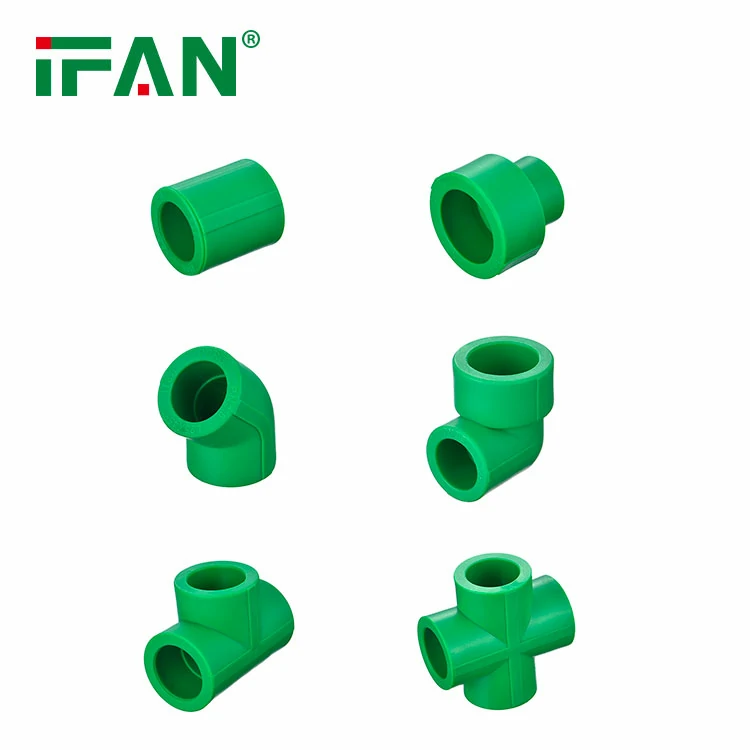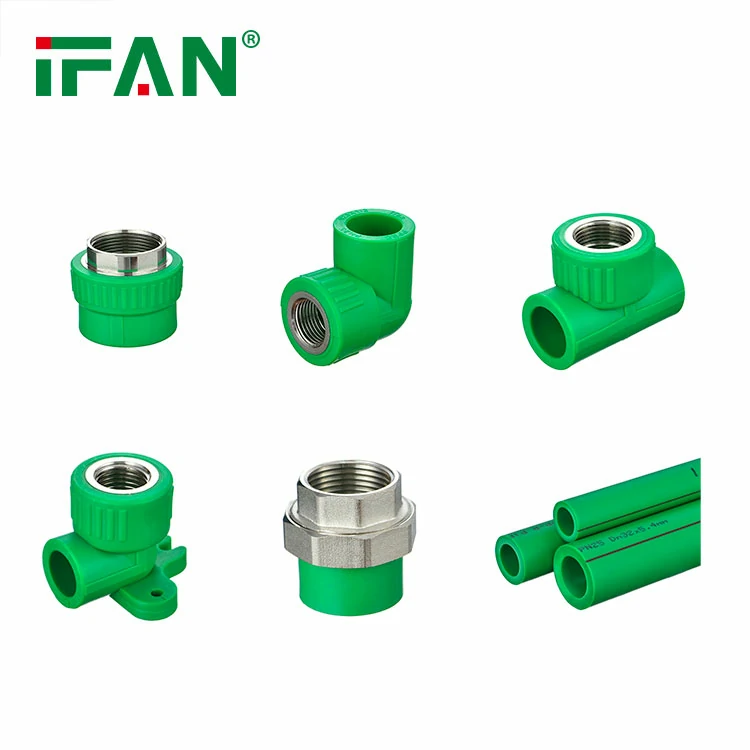IFAN factory 30+ years manufacture experience support color /size customization support free sample.Welcome to consult for catalog and free samples.This is our Facebook Website:www.facebook.com,Click to watch IFAN’s product video.Compared with Tomex products, our IFAN products from quality to price are your best choice, welcome to buy!
When it comes to plumbing, selecting the right fittings is crucial for ensuring the long-term functionality and safety of your water systems. PPR fittings, made from polypropylene random copolymer, are a popular choice for both hot and cold water installations due to their durability, resistance to corrosion, and easy installation process. This guide will help you navigate the selection of PPR fittings for your hot and cold water systems, ensuring you make informed decisions for your plumbing needs.
What Are PPR Fittings?
PPR fittings are components used to connect pipes in a plumbing system. They are made from polypropylene random copolymer, a thermoplastic material that is known for its superior resistance to heat, chemicals, and corrosion. The fittings are available in various shapes and sizes to suit different plumbing applications, including elbows, tees, couplings, ball valves, and reducers.
One of the most significant advantages of PPR fittings is their ability to withstand high temperatures, making them ideal for both hot and cold water systems. These fittings can endure water temperatures up to 95°C, which is why they are widely used in residential, commercial, and industrial water installations.
Why Choose PPR Fittings for Hot and Cold Water Systems?
There are several reasons why PPR fittings are an excellent choice for hot and cold water systems:
1. Durability
PPR fittings are highly resistant to physical wear and tear, which makes them ideal for plumbing applications. They are unaffected by high-pressure water flow and will not corrode, unlike metal fittings. As a result, PPR fittings can last for many years without the need for frequent maintenance or replacements.

2. Heat Resistance
PPR fittings can withstand temperatures up to 95°C, making them suitable for hot water systems, including underfloor heating systems, boilers, and other applications where high water temperatures are common. Their heat resistance ensures that they maintain their integrity even under hot water conditions, preventing leaks and damage.
3. Corrosion and Scaling Resistance
Unlike metal pipes and fittings, PPR fittings do not corrode over time. They are also resistant to scaling, which can be a common issue with metal systems when mineral deposits build up. This makes PPR fittings ideal for use in areas with hard water, ensuring your plumbing remains free from blockages and leaks.
4. Cost-Effective
Although the initial cost of PPR fittings can be higher than other materials such as PVC, they offer excellent value over the long term. Due to their durability and long lifespan, PPR fittings can help you save on maintenance and replacement costs, making them a cost-effective solution for both residential and commercial water systems.
5. Eco-Friendly
PPR fittings are made from recyclable materials, making them an environmentally friendly option compared to many other plastic materials used in plumbing systems. Choosing PPR fittings can help reduce your carbon footprint and contribute to a more sustainable future.
Choosing the Right PPR Fittings for Your Hot and Cold Water System
Selecting the correct PPR fittings for your water system depends on various factors, including the type of installation, the specific requirements of your plumbing system, and the local climate conditions. Here are some tips to help you choose the right fittings:
1. Consider Pipe Size and Compatibility
When choosing PPR fittings, it’s essential to consider the size of the pipes you will be using in your system. PPR fittings come in various diameters, and selecting the right size ensures a tight, leak-free connection. Make sure the fittings you choose are compatible with the pipe sizes in your installation.
If you’re working with a mix of different pipe sizes, PPR reducers can be used to connect pipes of varying diameters. Always double-check the compatibility of your pipes and fittings before installation.
2. Determine the Pressure and Temperature Requirements
For hot water systems, you’ll need PPR fittings that are designed to withstand high temperatures. Ensure the fittings you select are rated for the maximum temperature and pressure of your water system. Standard PPR fittings are suitable for most residential applications, but if you are dealing with industrial or high-pressure systems, you may need specialized fittings designed for those conditions.
3. Choose the Right Type of Fitting
There are various types of PPR fittings to consider, depending on your plumbing needs. Some common types include:
- Elbows: Used to change the direction of water flow in the system.
- Tees: Used for branching the pipe into multiple directions.
- Reducers: Connect pipes of different sizes.
- Couplings: Join two pipes of the same size together.
- Ball Valves: Control the flow of water through the system.
Choose the right fittings based on your layout and system design. For instance, if you’re installing a system with multiple branches, PPR tees and elbows will be essential.
4. Consider UV Protection for Outdoor Installations
If you are installing PPR fittings in an outdoor or exposed environment, UV protection should be considered. While PPR fittings are resistant to corrosion, prolonged exposure to UV light can degrade the material over time. You can protect the fittings by using UV-resistant coatings or installing them in shaded areas.
5. Evaluate the Quality of the Fittings
Not all PPR fittings are created equal. It’s important to choose high-quality fittings from reputable manufacturers to ensure long-term performance. Look for PPR fittings that are certified for use in potable water systems, ensuring they meet health and safety standards.

How to Install PPR Fittings
Installing PPR fittings is relatively straightforward, but it requires attention to detail to ensure a secure, leak-free connection. The process typically involves:
- Cutting the Pipes: Use a PPR pipe cutter to cut the pipes to the desired lengths. Make sure the cuts are straight and clean to avoid leaks.
- Heating the Fittings and Pipes: PPR fittings must be welded to the pipes using a PPR welding machine. Heat both the pipe and the fitting until they reach the correct temperature, typically around 260°C (500°F).
- Joining the Pipe and Fitting: Once both the pipe and fitting are properly heated, quickly insert the pipe into the fitting and hold them together until the joint cools. This process creates a strong, permanent bond.
- Testing for Leaks: Once the system is fully installed, turn on the water supply and check for any leaks around the joints. If everything is secure, your installation is complete.
Common Issues with PPR Fittings
Though PPR fittings are generally reliable, a few issues can arise during installation or over time:
- Improper Welding: Incorrect heating or alignment during the welding process can result in weak joints. Always ensure the pipe and fitting are properly heated before joining.
- Over-tightening: When using PPR ball valves or other threaded fittings, avoid over-tightening, as this can damage the threads or cause the fitting to crack.
- UV Degradation: Prolonged exposure to UV rays can weaken PPR fittings, especially in outdoor installations. Use UV-resistant coatings to protect them from damage.
FAQs
1. What are PPR fittings made of?
PPR fittings are made from polypropylene random copolymer (PPR), a thermoplastic material known for its resistance to heat, chemicals, and corrosion.
2. Can PPR fittings be used for hot water?
Yes, PPR fittings are designed to withstand temperatures up to 95°C, making them ideal for hot water systems.
3. How long do PPR fittings last?
With proper installation and maintenance, PPR fittings can last for 50 years or more.
4. Are PPR fittings safe for drinking water?
Yes, PPR fittings are safe for potable water systems as they do not release harmful chemicals and are resistant to bacterial growth.
5. Can PPR fittings be repaired?
Generally, PPR fittings cannot be repaired once damaged. However, replacing the damaged fitting is relatively easy by cutting out the damaged section and installing a new one.
Conclusion
PPR fittings are an excellent choice for both hot and cold water systems, offering durability, heat resistance, and corrosion protection. By considering the factors outlined in this guide—such as pipe size, pressure requirements, and fitting types—you can ensure the success of your plumbing installation. Whether you’re upgrading an existing system or starting a new project, PPR fittings will provide a long-lasting and reliable solution for your water systems.





